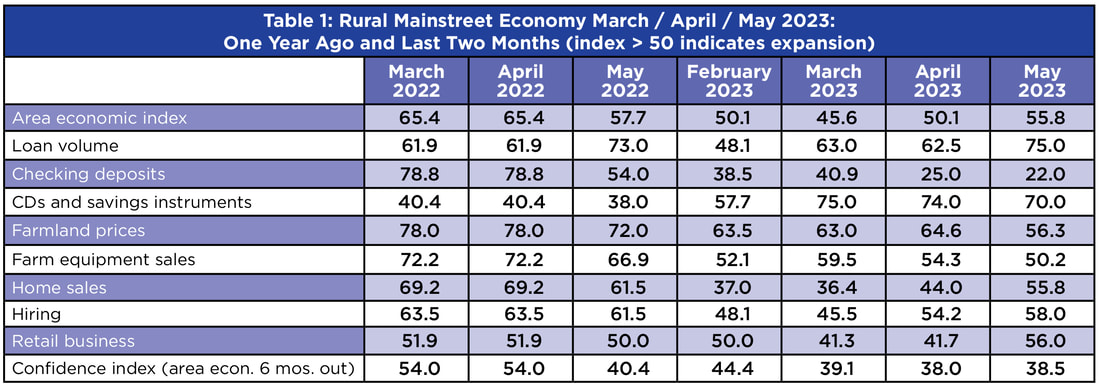- After hovering around growth neutral for three straight months, the region’s overall economic reading slumped below the threshold to its lowest reading since October of last year.
- Farmland prices have now advanced for 30 straight months.
- After advancing by over 9% for 2022, bank CEOs expect farmland prices to expand by only 1% over the next 12 months.
- Only 13.6% of bankers tightened credit standards for farm loans this year.
- Approximately 87% of bankers recommend a Federal Reserve rate hike at its next meetings, March 21-22, with almost one-third supporting a 0.50% increase.
- Bank savings deposits rose to a record level.
OMAHA, Neb. (March 16, 2023) -- After three straight months of readings slightly above growth neutral, the Creighton University Rural Mainstreet Index (RMI) fell below the growth neutral threshold, 50.0, according to the latest monthly survey of bank CEOs in rural areas of a 10-state region dependent on agriculture and/or energy.
Overall: The region’s overall reading in March sank below the growth neutral threshold. The March index slumped to 45.6 from 50.1 in February. The index ranges between 0 and 100, with a reading of 50.0 representing growth neutral.
“The Rural Mainstreet economy continues to experience slow, to no, to negative economic growth. Less than 1% of bankers reported improving economic conditions for the month with 92% indicating no change in economic conditions from February’s slow growth,” said Ernie Goss, PhD, Jack A. MacAllister Chair in Regional Economics at Creighton University’s Heider College of Business.
Farming and Ranching: The region’s farmland price index decreased to 63.0 from February’s 63.5. This was the 30th straight month that the index has advanced above 50.0.
Farm Equipment Sales: As a result of solid farm financial conditions, the farm equipment-sales index climbed to 59.5 from 52.1 in February. The index has risen above growth neutral for 26 of the last 28 months.
Banking: The March loan volume index rose to a strong 63.0 from 48.1 in February and was up from 61.9 in March 2022. The checking-deposit index increased to 40.9 from February’s 38.5, while the index for certificates of deposit and other savings instruments expanded to a record high of 75.0 from February’s solid 57.7.
Bank CEOs were asked what interest rate action the Federal Reserve should undertake at their March 21-22 meetings. Approximately 56.5% recommended a 0.25% rate increase; 30.5% supported a 0.50% boost; and 13% advocated no rate change. However, most survey responses were completed prior to recent bank failures.
According to Jeffrey Gerhart, former Chair of the Independent Community Bankers of America, “It’s too bad that the Fed waited so long to raise interest rates. They could have begun raising interest rates sooner than they did and would not have had to raise them as fast as they’ve done.” Gerhart applauds the Fed for raising interest rates and its willingness to stay the course to get a handle on inflation.
Hiring: The new hiring index for March sank to 45.5 from 48.1 in March. Labor shortages continue to be a significant issue constraining growth for Rural Mainstreet businesses.
Confidence: The slowing economy, higher borrowing costs and labor shortages continued to constrain the business confidence index to a weak 39.1 from 44.4 in February. “Over the past 12 months, the regional confidence index has fallen to levels indicating a very negative outlook,” said Goss.
Home and Retail Sales: The home-sales index sank to a very weak 36.4 from February’s 37.0. “This is the tenth straight month that the home-sales index has fallen below growth neutral. An almost doubling of the 30-year mortgage rate over the past year and low inventory levels slowed home sales in the region over that time period,” said Goss.
The retail-sales index for March dropped to 41.3 from February’s 50.0. “Bankers were pessimistic regarding the economic outlook with downward pressure on retail sales for the first quarter of 2023,” said Goss.
| Colorado: Colorado’s Rural Mainstreet Index (RMI) for March fell to 50.3 from 60.6 in February. The farmland- and ranchland-price index advanced to 64.3 from 62.6 in February. The state’s new hiring index was 47.8 for March. USDA data for the top five exported agriculture products for Colorado indicate that for the first quarter of fiscal 2023, the state exported $496.3 million. This represented $1.01 per $1,000 of state GDP. Illinois: The March RMI for Illinois increased to 42.0 from February’s 31.0. The farmland-price index climbed to 60.8 from 55.2 in February. The state’s new-hiring index rose to a weak 43.5 from February’s 38.3. Jim Eckert, CEO of Anchor State Bank in Anchor, Ill., stated that, “Given the very mild winter we've had here, farmers expect more insect problems than in recent years. A few oats have been sewn and farmers are looking towards early planting.” USDA data for the top five exported agriculture products for Illinois indicate that for the first quarter of fiscal 2023, the state exported $2 billion. This represented $1.89 per $1,000 of state GDP. Iowa: Iowa’s March RMI slumped to 46.7 from 56.9 in February. Iowa’s farmland-price index fell to 55.6 from February’s 63.7. Iowa’s new-hiring index for March moved down to 37.1 from February’s 48.8. USDA data for the top five exported agriculture products for Iowa indicate that for the first quarter of fiscal 2023, the state exported $983.9 million. This represented $4.21 per $1,000 of state GDP. Kansas: The Kansas RMI for March dropped to 43.6 from February’s 53.5. The state’s farmland-price index declined to 61.4 from February’s 70.1. The new-hiring index for Kansas plummeted to 44.3 from 50.2 in February. USDA data for the top five exported agriculture products for Kansas indicate that for the first quarter of fiscal 2023, the state exported $942 million. This represented $4.43 per $1,000 of state GDP. Minnesota: The March RMI for Minnesota increased slightly to 43.7 from February’s 43.4. Minnesota’s farmland-price index climbed to 61.5 from 60.5 in February. The new-hiring index for March slumped to 44.4 from 44.8 in February. USDA data for the top five exported agriculture products for Minnesota indicate that for the first quarter of fiscal 2023, the state exported $433.2 million. This represented $0.96 per $1,000 of state GDP. | Missouri: The state’s March RMI dropped to 44.5 from 49.8 in February. The farmland-price index fell to 61.8 from February’s 63.2. The state’s new hiring gauge shrank to 44.8 from 48.2 in February. USDA data for the top five exported agriculture products for Missouri indicate that for the first quarter of fiscal 2023, the state exported $477.6 million. This represented $1.22 per $1,000 of state GDP. Nebraska: The Nebraska RMI sank below growth neutral to 48.3 from 53.1 in February. The state’s farmland-price index for March decreased to 63.4 from February’s 64.6. Nebraska’s March new-hiring index slumped to 46.8 from 49.9 in February. USDA data for the top five exported agriculture products for Nebraska indicate that for the first quarter of fiscal 2023, the state exported $868.8 million. This represented $5.30 per $1,000 of state GDP. North Dakota: North Dakota’s RMI for March plummeted to 39.0 from February’s 50.4. The state’s farmland-price index sank to 59.5 from 63.5 in February. The state’s new-hiring index declined to 41.9 from 48.5 in February. USDA data for the top five exported agriculture products for North Dakota indicate that for the first quarter of fiscal 2023, the state exported $225.1 million. This represented $2.99 per $1,000 of state GDP. South Dakota: The March RMI for South Dakota increased to 47.2 from 44.8 in February. The state’s farmland-price index decreased to 58.8 from February’s 59.6. South Dakota’s March new hiring index fell to 41.0 from 43.7 in February. USDA data for the top five exported agriculture products for South Dakota indicate that for the first quarter of fiscal 2023, the state exported $355.4 million. This represented $5.20 per $1,000 of state GDP. Wyoming: The March RMI for Wyoming slumped to 41.7 from 42.8 in February. The March farmland- and ranchland-price index increased to 60.6 from 60.2 in February. Wyoming’s new-hiring index sank to 43.3 from February’s 44.5. USDA data for the top five exported agriculture products for Wyoming indicate that for the first quarter of fiscal 2023, the state exported $700 thousand. This represented $0.01 per $1,000 of state GDP. |



 RSS Feed
RSS Feed